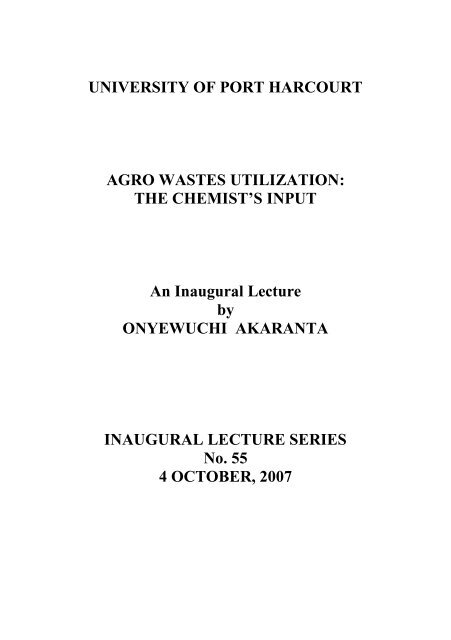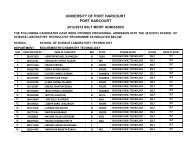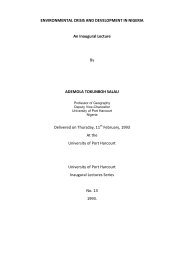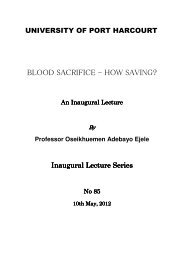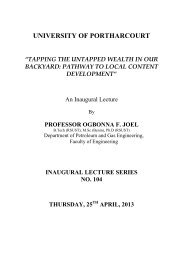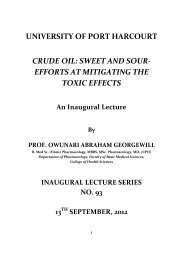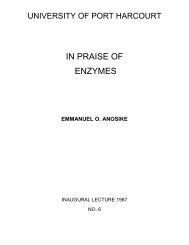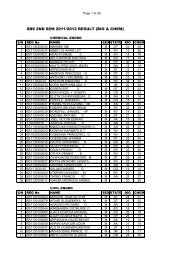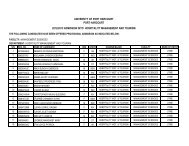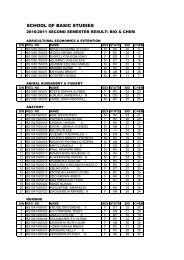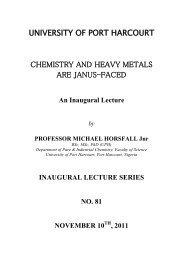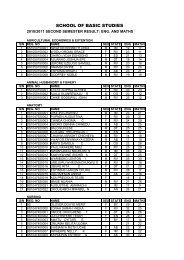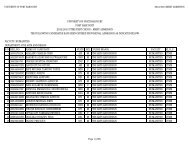55th Inaugural Lecture - 2007 by Prof. O. Akaranta - University of ...
55th Inaugural Lecture - 2007 by Prof. O. Akaranta - University of ...
55th Inaugural Lecture - 2007 by Prof. O. Akaranta - University of ...
Create successful ePaper yourself
Turn your PDF publications into a flip-book with our unique Google optimized e-Paper software.
UNIVERSITY OF PORT HARCOURTAGRO WASTES UTILIZATION:THE CHEMIST’S INPUTAn <strong>Inaugural</strong> <strong>Lecture</strong><strong>by</strong>ONYEWUCHI AKARANTAINAUGURAL LECTURE SERIESNo. 554 OCTOBER, <strong>2007</strong>
DEDICATIONTo Wealth Creation from Wastes and aPollution Free Environmentii
The Vice – Chancellor, Sir,Members <strong>of</strong> the Governing Council here Present,Deputy Vice – Chancellors,Registrar and other Principal Officers,Provost, College <strong>of</strong> Health Sciences,Dean <strong>of</strong> Graduate School,Deans <strong>of</strong> Faculties,Distinguished Colleagues,Great Students <strong>of</strong> Unique Uniport,Ladies and Gentlemen <strong>of</strong> the Press,My Lords Spiritual and Temporal,Ladies and Gentlemen.INTRODUCTIONIt is with a deep sense <strong>of</strong> humility that I follow the nobletradition <strong>of</strong> academia <strong>by</strong> delivering the 55 th <strong>Inaugural</strong> <strong>Lecture</strong><strong>of</strong> the <strong>University</strong> <strong>of</strong> Port Harcourt. <strong>Pr<strong>of</strong></strong>essor C. M. Ojinnaka(FCSN, FICCON), an erudite <strong>Pr<strong>of</strong></strong>essor <strong>of</strong> Chemistry deliveredthe first <strong>Inaugural</strong> <strong>Lecture</strong> from the Department <strong>of</strong> Pure andIndustrial Chemistry in 1998. I appreciate his contributions1
towards the advancement <strong>of</strong> Chemistry and the support he hadgiven me in my academic pursuit / career.Mr. Vice-Chancellor, Sir, barely four weeks <strong>of</strong> yourassumption <strong>of</strong> <strong>of</strong>fice in 2005, you concluded my pr<strong>of</strong>essorialassessment that started in 2002. I am sincerely grateful andproud to announce to you that this is the second inaugurallecture from the Department <strong>of</strong> Pure and Industrial Chemistry,but the first in Industrial Chemistry discipline.An inaugural lecture affords one the opportunity toshare with the distinguished audience ones academicachievements, concerns and articulate ones expectations in nontechnical and pr<strong>of</strong>essional language. Mr Vice –Chancellor, Sir,the topic <strong>of</strong> this lecture is, Agro Wastes Utilization: TheChemist’s Input.Chemistry In AgricultureMethods <strong>of</strong> cultivating the soil, harvesting crops, raisinglivestock have changed with time. Today’s agriculture relieson a wide range <strong>of</strong> fertilizers, fungicides, pesticides, herbicidesand hormones. The benefits <strong>of</strong> using these chemicals inmodern agriculture include increase in agricultural produce2
Table 1: Residues from the Processing and Harvesting <strong>of</strong>Some Agricultural Produce.AgriculturalProduceCorn, Wheat,RiceCattleResiduesGeneratedStraw, StalksHusks, CobsAnimal Waste e.g.Blood, Bone,DungPotential use <strong>of</strong> ResiduesAnimal feedstuff, Fuel,Silica, Furfural, Compost,Chemical FeedstockAnimal glue, Animal FeedSupplement, MethaneProduction, ActivatedCarbon, ManureSugarcane Bagasse Fuel, Furfural, Animal feedParticle Boards,BiopolymersFruits andVegetablesPotatoesOils andOilseedsCoconutSeeds, Peels,HusksStarch WasteWaterShells, Husk,Fibres, Sludge,Press CakeCoir Dust, Fibres,Shell.Animal and Fish Feed, FuelCompost and FermentationSugars and Alcohols,Single Cell ProteinAnimal feed, Fertilizers,Fuel, Activated Carbon,Furfural,Resins, Pigments, Fillers,Mats, Activated Carbon,Tanning Materials.4
Table 1 shows a broad range <strong>of</strong> agricultural residues (wastes)usually produced from harvesting and processing <strong>of</strong>agricultural commodities. All crops produce collectableresidues, however the collection process may increase the cost<strong>of</strong> utilization. Sugarcane, fruits, grains and nuts are crops thatgenerate significant amount <strong>of</strong> residues at the processing sites.Bloods and bones from abattoirs and livestock wastes areanimal residues <strong>of</strong> importance.INDUSTRIAL RAW MATERIALS AND PRODUCTSFROM AGRO-WASTESA raw material is that primary input which when subjected tosome chemical and/or physical processes becomes convertedto a valuable product that can be exchanged for money (Fasina,1985). To a palm oil mill, palm fruit is the raw material, whilepalm oil, palm kernel and palm fruit fibres are end products.The palm kernel is the raw material for the production <strong>of</strong> palmkernel oil, which is subsequently used for the production <strong>of</strong>vegetable oils and soaps. In the same vein, palm fruit fibres areused for the production <strong>of</strong> furfural (Saad et al, 1978). Furfuralis a raw material for the production <strong>of</strong> phenol – furfural resins5
usually used in the production <strong>of</strong> some plastic wares. An endproduct <strong>of</strong> one industry may become the feedstock (rawmaterial) for another industry.Industrial raw materials are either <strong>of</strong> mineral, animal orvegetable origin. Mineral sources include petroleum, ores, andcoal, while animal sources are: fats, hides and skins, bloodsand bones. Vegetable sources include vegetable oils, timbers,cereals, tubers and nuts. The vegetable sources occupy animportant position in the provision <strong>of</strong> industrial raw materials.This is because they are readily renewable resources. The rapidincreasing world population, high demand for industrial rawmaterials and the realization that the supply <strong>of</strong> raw materialsfrom mineral sources is finite have given significance to therenew-ability <strong>of</strong> raw materials.Although vegetable sources <strong>of</strong> raw materials are readilyrenewable, the utilization <strong>of</strong> agricultural residues as sources <strong>of</strong>industrial raw materials will help in sustaining the highdemand for industrial raw materials and reduce the cost <strong>of</strong> theend products. It will also reduce the environmental pollutionsusually caused <strong>by</strong> indiscriminate dumping <strong>of</strong> such wastes. Inthe <strong>University</strong> <strong>of</strong> Port Harcourt, value – added products have6
een obtained from agricultural wastes through the application<strong>of</strong> chemical processes.Crop ResiduesThese are residues produced mainly during the processing <strong>of</strong>crops. They include husks, red onion and peanut skins, corncob, palm fruit fibres etc.Rice Bran OilThe production <strong>of</strong> white rice goes hand in hand with theproduction <strong>of</strong> its <strong>by</strong>-product known as rice bran, the brownskin that covers the rice grain. It is the most valuable “waste”<strong>of</strong> the rice milling industry due to its high industrial andnutritive potentials. It contains about 15-25% oil. In view <strong>of</strong>the fact that the vegetable oil industry in developing countrieshas severe shortage <strong>of</strong> raw material, rice bran appears to bewell on its way to becoming a recognized raw material for theproduction <strong>of</strong> vegetable oils and protein based animal feeds(UNIDO, 1985).7
Orange Seed and Peel OilsAll seeds contain oils (Ajiwe et al, 1997), but the quantity andthe chemical constituents <strong>of</strong> the oil in any seed determine itscommercial value. Orange seed oil has been extracted withfeint, a distillery waste liquid containing mainly C 2 -C 4 alcohols(<strong>Akaranta</strong> and Anusiem, 1996). The oil is made up <strong>of</strong> thefollowing fatty acids: palmitic acid 5.8%, stearic acid 4.0%,oleic acid 56.0% with traces <strong>of</strong> linoleic acid and has an iodinevalue <strong>of</strong> 108. It is a semi-drying oil and has been used in theformulation <strong>of</strong> surface coatings (Emeledor, 1991). If a freshorange peel (the epicarp) is squeezed near a flame it ignites.This is due to the presence <strong>of</strong> some volatile and flammablecompounds in the peel. The compounds include: limonene,myecene, alpha-terpineol, aliphatic alcohols and aldehydes(Formacek and Kubeczka, 1982) and are collectively calledessential oil. The oil has been extracted using steam distillationaPnd expression methods (Masada, 1976). Orange peel oil isused as fragrance in perfumes and to flavour beverages, icecream, candy and chewing gum (Nwobi et al, 2006).8
ResinsCoconut coir dust (Tuason and Reyes, 1959), red onion skin(Odozi et al, 1984) and peanut skin (Stansbury et al, 1950) areagricultural wastes known to contain flavonoids. Theflavonoids are easily extracted with hot water, dilute alkalinesolutions or polar solvents such as acetone and alcohols. Theflavonoids are phenolic in nature and for that reason have beenused in the production <strong>of</strong> phenol-aldehyde type <strong>of</strong>condensation resins.Wood varnishes have been developed using the condensationproducts <strong>of</strong> red onion skin extract and aldehydes (Odozi et al,1985). Excellent oleoresinous varnishes have also beenproduced from copolymer resins <strong>of</strong> peanut skin extract,aldehydes and cashewnut shell liquid (<strong>Akaranta</strong> et al. 1994).The adhesive properties <strong>of</strong> resins obtained <strong>by</strong> copolymerisingred onion skin (<strong>Akaranta</strong> et al, 1996; Odozi and Agiri, 1986;Odozi et al, 1986), coconut coir dust (<strong>Akaranta</strong> and Wankasi,1996) or peanut skin (Chen, 1982) extracts with aldehydes andsynthetic phenols have been reported. The results obtainedshowed that the resins exhibited adhesive properties that9
satisfied International Standards Organization (ISO)requirements for exterior grade adhesives.Antioxidants and InhibitorsFlavonoids <strong>of</strong> red onion and peanut skin extracts have beenevaluated as antioxidants for vegetable oils and as inhibitorsfor unwanted polymerisation <strong>of</strong> some vinyl monomers. Theextracts were effective as antioxidants in vegetable oils but atslightly higher concentrations when compared withcommercial phenolic antioxidants (<strong>Akaranta</strong> and Odozi, 1986;<strong>Akaranta</strong>, 1994). Similar trends have been reported with theextracts when evaluated as inhibitors for the polymerisation <strong>of</strong>vinyl monomers (<strong>Akaranta</strong>, 1999).Dyes and PigmentsIt has been reported that red onion skin extract containspolyphenols <strong>of</strong> the flavonoid type (Odozi et al, 1984) whichare capable <strong>of</strong> directing nucleophilic reactions to the ortho andpara positions (<strong>Akaranta</strong> and Odozi, 1985). The extract hasbeen coupled with diazonium salts to give azo dyes <strong>of</strong> variouscolours (<strong>Akaranta</strong> and Efanga, 1997).10
Figure 1: Reaction <strong>of</strong> Red Onion Skin Extract with aDiazonium SaltThe azo dyes were formed in-situ in cotton fabrics asazoic dyes and applied to polyester fabrics as disperse dyes.They were found to produce not very bright colours onpolyester fabrics but brilliant colours on cotton fabrics. Thewashfastness tests <strong>of</strong> the azo dyes on both cotton and polyesterfabrics were satisfactory. The azo dyes with suitable chelatinggroups have been used to produce azo-metal complexessuitable for the pigmentation <strong>of</strong> alkyd resins in paintformulation. (<strong>Akaranta</strong>, 1996).11
Figure 2:A Red Onion Skin Extract Azo MetalCompoundTanning AgentsTannin molecules <strong>of</strong> vegetable origin have been used sinceages for the conversion <strong>of</strong> hides and skins into leather. Themost widely used tannin molecules are the condensed typesusually found in minosa, quebracho and mangrove barkextracts. The later part <strong>of</strong> the 20 th century witnessed a shift tothe use <strong>of</strong> synthetic tanning agents based on phenols due to theemergence <strong>of</strong> petrochemicals, which are readily availablesources <strong>of</strong> synthetic phenols. The ever increasing cost <strong>of</strong>petrochemicals, particularly phenols, has again stimulatedinterests in the search for effective, cheap and renewablesources <strong>of</strong> condensed tannins. Among the renewable sources,the most convenient source to explore is the agriculturalwastes. Peanut skin, coconut coir dust and red onion skin12
extracts and their derivatives have been found to possess goodtanning properties (<strong>Akaranta</strong>, 1999).Lignocellulosic ResiduesThey are those agricultural residues that contain cellulose,hemicellulose and lignin as their major components. Theseinclude such residues as sugarcane bagasse, orange mesocarp,corn cob, peanut husk, palm fruit fibres, melon seed shell etc.Particle BoardsThe most commonly available type <strong>of</strong> industrial woodproducts such as particle boards are made from wood chipsobtained from forest thinnings, timber and saw mill wastes.However, the declining potentials <strong>of</strong> our forest due todeforestation makes it difficult to meet up the rapidlyincreasing demand for particle boards in future. The situationhas been further aggravated <strong>by</strong> the rapid increase in thepopulation <strong>of</strong> developing countries. Therefore, in order to meetthe raw material requirements for particle board production,agricultural residues appear to be the most attractive andpromising source. (<strong>Akaranta</strong>, 2000). In this regard, corn cob,sugarcane bagasse and peanut husk have been used as sources13
<strong>of</strong> lignocellulosic materials for chips, while red onion andpeanut skins have been used as sources <strong>of</strong> phenols foradhesives in the production <strong>of</strong> particle boards (Odozi et al,1986). Performance evaluation results <strong>of</strong> the boards showedthat boards produced using agricultural residues were superiorto the commercial grade boards made from wood chips andusually bonded with modified urea-formaldehyde resinadhesives.Jute stick which is obtained as an agricultural residuefrom jute cultivation has three major components: α -cellulose 41%, pentosan 22% and lignin 23%. Ligninrecovered from the spent liquor <strong>of</strong> soda pulping <strong>of</strong> jute stickhas been used for the production <strong>of</strong> lignin – phenolformaldehyde resins. The resins were then used as adhesives toproduce particle boards from jute stick chips (Roy et al, 1989).Activated CarbonsDyes and pigments in some industrial effluents are <strong>of</strong>tendischarged into receiving rivers and their high degree <strong>of</strong> colouris easily detectable and detracts the aesthetic value <strong>of</strong> a river.The removal <strong>of</strong> these dyes and pigments from such effluents inan economic manner is still posing some challenges, even14
though a number <strong>of</strong> adsorption techniques have beendeveloped for their removal from effluents (Robinson et al,2001).In order to reduce the cost <strong>of</strong> treating industrialeffluents, coconut shell, an agricultural residue has beenconverted into decolourising carbons and successfully used toremove dyes and pigments from effluents (Singh and Raman,1976). Palm Kernel shell has also been used for the production<strong>of</strong> activated carbons suitable for the removal <strong>of</strong> dyes fromsolutions (Odozi and <strong>Akaranta</strong>, 1986). Granular Activatedcarbons (GACs) have been produced from other agriculturalresidues (Johns and Marshall, 1994). The GACs are capable <strong>of</strong>qualitatively removing metal ions from effluents. Therefore, itis now possible to produce from agricultural residues activatedcarbons that are capable <strong>of</strong> removing dyes, pigments and metalions from industrial effluents.FurfuralPentosan containing agricultural residues yield furfural upontreatment with mineral acids.15
Pentosan an aldopentose furfural(in an agro-waste)Corn cob, rice and peanut husks are lignocellulosicresidues that readily yield furfural when subjected to acidhydrolysis (Dunlop, 1966). Saad et al (1978) optimised theconditions for the formation <strong>of</strong> furfural <strong>by</strong> acid hydrolysis <strong>of</strong>palm fruit fibres. The pentosan containing agricultural wastescan be pulled together and used for the commercial production<strong>of</strong> furfural. The industrial uses <strong>of</strong> furfural have been reviewed(Kovaly, 1982).Animal FeedsOne <strong>of</strong> the major problems in the utilization <strong>of</strong> lignocellolusicresidues for animal feed production is the difficulty usuallyencountered when digesting such residues using chemicaland/or biochemical processes. Mild pre-treatment <strong>of</strong> suchresidues with steam, acid or alkali helps in loosening the16
crystalline lignocellulosic structures, thus improving theutilization <strong>of</strong> the treated substrate <strong>by</strong> micro-organisms, with anincrease in the nutritive value <strong>of</strong> the residues (Gupta et al,1986). Agricultural residues might provide greater portion <strong>of</strong>animal feed supply if the problem <strong>of</strong> making such residuesmore digestible for animals is overcome.Alkali treatment has shown promise in making cropand wood residues more digestible for animals. In addition toits effect on digestibility, when ammonia is used for pretreatment,it provides nitrogen for microbial protein synthesisand effectively inhibits spoilage <strong>of</strong> the feed during storage(Fontenot, 1980).Carboxymethylated CelluloseCellulose isolated from orange mesocarp, a lignocellulosicresidue, has been carboxymethylated to a degree <strong>of</strong>substitution <strong>of</strong> 0.45-0.63 and used in the formulation <strong>of</strong> drillingmud (<strong>Akaranta</strong> and Osuji, 1997).17
HOHOOH + ClCH 2COONaalkalinesolution(NaOH)HOHOOCH 2COONa + NaCl + H 2OCelluloseSodium monoChloroacetateSodium CarboxymethylcelluloseCellulose has little tendency to swell in water, but theintroduction <strong>of</strong> carboxymethyl groups into cellulose moleculethrough the reaction between alkali cellulose and sodiummonochloroacetate to produce carbxymethyl cellulose (CMC),increases the tendency <strong>of</strong> cellulose to swell in water.Carboxymethylated cellulose, the sodium form, swells in coldwater to give a highly viscous gel.Carboxy methylated cellulose has applications insurface coatings, pharmaceutical, detergent and cosmeticindustries. The use <strong>of</strong> cellulose isolated from agriculturalresidues for the production <strong>of</strong> carboxymethylated productswould reduce the rate <strong>of</strong> exploitation <strong>of</strong> established sources <strong>of</strong>cellulose. It will also have a direct cost reduction effect on theproducts. Corn cob, rice and peanut husks have been used assources <strong>of</strong> cellulose for the production <strong>of</strong> carboxymethylatedcellulose and related products (<strong>Akaranta</strong>, 1996).18
Carbohydrate ResiduesCassava, which contains mainly carbohydrates, is leading theway in the international drive to promote the use <strong>of</strong> bio-fuels tosupplement and reduce world dependence on fossil fuel assource <strong>of</strong> energy. Food and Agricultural Organization (FAO)recent findings indicate that with the price <strong>of</strong> petroleumrunning at $ 60 or higher per barrel, it is quite pr<strong>of</strong>itable toconvert cassava into bio-fuel for use separately or as a mixturewith fossil fuel for energy (FAO <strong>2007</strong>).The presidential initiative on cassava has increased thelevel <strong>of</strong> cassava production in Nigeria leading to acorresponding increase in cassava residues to the point thatcassava is fast becoming an agricultural commodity with thehighest volume <strong>of</strong> wastes in Nigeria.Cassava peel, the mesocarp, which is a major residueemanating from the processing <strong>of</strong> cassava tubers has been usedto raise pigs, sheep and goats (Montilla, 1977; Adebowale,1985; Fetuga and Tewe, 1985; Tewe 1987). The resultsobtained <strong>by</strong> using such an agricultural waste in feedinglivestocks were not very encouraging due to its highhydrocyanic acid content (Conn, 1979). Fermented cassava19
peel has been reported as a good poultry feed when formulated(Ofuya and Obilor, 1993).Similarly, carbohydrate residues obtained during theconversion <strong>of</strong> cassava pulp into the edible form “garri” hasbeen carboxymethylated to give carboxymethylated starch(CMS) and subsequently used in the formulation <strong>of</strong> latexemulsion paints (Odozi et al, 1986).Cassava mesocarp carbohydrate and its chemicallymodified form have been used as fillers in low densitypolyethylene to produce plastic films that are biodegradable(<strong>Akaranta</strong> and Oku, 1997).The modification <strong>of</strong> the cassava mesocarp carbohydrateto its acetate form made it hydrophobic and therefore more20
compatible with the polyethylene. Such biodegradable plasticfilms are environment friendly.Carbohydrate residues are the major raw materials forthe production <strong>of</strong> biopolymers and single cell protein(Shipman and Fan, 1978).Animal ResiduesThe accumulation <strong>of</strong> animal residues causes severeenvironmental pollution. The utilization <strong>of</strong> the residues otherthan as manure has proceeded mainly through biological andthermochemical processes. The biochemical process producesprimarily sugars and alcohols, while the anaerobicfermentation produces methane.The thermochemical process involves dehydration andhydrocarbonation to yield char (carbon), oil and gaseous fuels.The greatest handicap <strong>of</strong> the thermochemical process is thelarge amount <strong>of</strong> moisture that needs to be removed to make theprocess feasible.Dried animal blood, which is sometimes used asorganic fertilizer, contains about 12% nitrogen with traces <strong>of</strong>phosphorous, iron, copper and other minerals. It is <strong>of</strong>ten mixed21
with superphosphates and used as compound fertilizer(Divakaran, 1982). The nutritive value <strong>of</strong> animal bloods fromabattoirs has been reported (Neelakantan, 1975) and usedprimarily as a source <strong>of</strong> protein (Halliday, 1975).Blood char is a form <strong>of</strong> activated carbon from animalblood. It serves as an adsorbent, capable <strong>of</strong> adsorbing gasesmany times its volume. Blood char selectively adsorbscolouring matters from solutions under specified conditionsand is thus used as industrial decolourant, particularly in thesugar industry, and in gas masks (Mattson and Mark, 1971;Smisek and Cerry, 1977).Animal blood has been used for the production <strong>of</strong>blood albumin (Divakaran, 1982). It is usually obtained fromcoagulated animal blood. Commercially available bloodalbumin usually called dried blood serum is a cheap substitutefor egg albumin powder. Blood albumin is <strong>of</strong>ten used to obtainlighter coloured protein finishes for leather and gives highlustre without altering the breathing property, unlike syntheticresin finishes that block the pores in leather. Blood albumin issoluble in water and in suitable concentrations provides highlytacky solutions that give firm adhesive properties. The22
substrate joints that are bonded with blood albumin basedadhesives can be made water resistant <strong>by</strong> heat or formaldehydetreatment.AGRO-WASTES IN EFFLUENTS TREATMENTThe input <strong>of</strong> metal ions from effluents, particularly fromindustrial processes, has been <strong>of</strong> much concern toenvironmental protection agencies because <strong>of</strong> the possibleecological consequences <strong>of</strong> discharging such effluents intoreceiving waters. Metal poisoning from wastewater occurred inMinamata Bay in Japan in 1953 when a factory using mercurycompounds as raw materials discharged its effluents into thesurrounding river. This resulted in the death <strong>of</strong> many peoplewho consumed fish from the river (Ui,1992). Environmentalprotection agencies such as Federal Environmental ProtectionAgency (FEPA) and United States Environmental ProtectionAgency (USEPA) have put in a lot <strong>of</strong> efforts to set the limits <strong>of</strong>various toxic metals in effluents before they are dischargedinto the receiving environment.Industrial effluents treatment systems employ a variety<strong>of</strong> physical and / or chemical methods in treatment plants.23
(Azbar et al 2004). The methods include chemicalprecipitation, electro deposition, cementation, ultra filtration orreverse osmosis, ion exchange and activated carbonadsorption. Cation exchange resins are particularly effective inremoving metal ions and other positively charged species fromaqueous solutions. Activated carbons are finding increased useas metal ions scavengers because <strong>of</strong> the high cost <strong>of</strong> cationexchange resins derived from petroleum resources. The needfor effective and economic removal <strong>of</strong> toxic/valuable heavymetal ions and organic pollutants in industrial effluents hasresulted in a search for unconventional methods and materialsthat might be useful in industrial effluents treatment (Kumarand Dara, 1981).Agricultural residues, especially those from widelygrown commodity crops, are quite inexpensive and have beenshown to possess natural adsorbent properties (Waiss et al,1973; Young et al, 1973, Waiss and Friedman, 1972). Theadsorbent properties <strong>of</strong> the unmodified agricultural residuesare due to the presence <strong>of</strong> carboxylic, phenolic and hydroxylgroups in the substrates. However, the sorption capacities <strong>of</strong>24
agricultural residues can be enhanced <strong>by</strong> chemicalmodifications.Alkali Treated Agricultural ResiduesAzab and Peterson (1989) reported that alkali treated peanuthull removed 99% cadmium ion from solution in columnapplications. This is an improvement over the untreated peanuthull which removed 68% cadmium ion. Akali treatment <strong>of</strong>crystalline lignocellulosic agricultural residues helps inloosening the crystalline structures thus improving theexchange capacities <strong>of</strong> the treated substrates. The resultsobtained with the alkali treated peanut hull in the uptake <strong>of</strong>cadmium ion is an indication that other agricultural residueswith similar chemical compositions as peanut hull would beexpected to show improved exchange capacities when treatedwith alkalis. Hence increasing the number <strong>of</strong> agriculturalresidues, that can effectively remove metal ions from industrialeffluents.Polymerised Agricultural ResiduesUsing polymerised agricultural residues in effluents treatment,Kumar and Dara (1981) reported that formaldehyde25
polymerized onion skin is highly effective for binding heavymetal ions from aqueous solutions. The exchange capacity <strong>of</strong>the substrate for a number <strong>of</strong> the metal ions studied was wellabove 1 meq/g. Similarly, Randall et al (1978) reported thatformaldehyde polymerised peanut skin can quantitativelyremove lead, copper, mercury and cadmium from industrialeffluents. The function <strong>of</strong> formaldehyde in the process is t<strong>of</strong>orm a high molecular weight compound with the tanninmolecules in the peanut skin. This prevents the tanninmolecules from leaching out <strong>of</strong> the substrate. When thesubstrate is sulphonated, the tannin molecules provide the basefor the introduction <strong>of</strong> sulphonic acid groups into the tanninaromatic nuclei. The sulphonic acid and the hydroxyl groupsare responsible for the enhanced exchange capacities <strong>of</strong>formaldehyde polymerized and sulphonated agriculturalresidues.Odozi and Emelike (1985) reported that polymerisedred onion skin tannin/corn cob powder produced good cationexchange resins for the removal <strong>of</strong> heavy metal ions fromaqueous solutions. The ion exchange capacity <strong>of</strong> the corncobbased resins was above 1 meq/g, a value in keeping with26
commercial ion exchange resins. Therefore resins derived <strong>by</strong>polymerising tannin molecules and corncob can serve aseffective substitutes for commercial cation exchange resins.The corn cob serves to produce the furfural which is thenpolymerises with the red onion skin tannin molecules to formthe resins.The batch experiments carried out using the corn cobhydroxylate – red onion skin tannin resins showed that thefinal pH is always less than the initial pH. Accordingly, it wasconcluded that the corn-cob-red onion skin product acts as anacidic ion – exchanger since H + ions are released into thesolution as the metal ions are bound to the substrate. Thus, theequilibrium attained corresponds to a solution <strong>of</strong> lower pHthan that <strong>of</strong> the original test solution. Similar observation wasreported <strong>by</strong> Randall et al (1975) while using formaldehydepolymerised peanut skin tannin resins to remove copper ionsfrom aqueous solutions. However, for the metal salts <strong>of</strong> acetateanion, no reasonable lowering <strong>of</strong> pH was observed owing tothe buffering effect <strong>of</strong> the acetate ion. As expected for benzenesulphonic acid cation exchangers, the ion exchange process <strong>of</strong>various divalent metal ions from their solutions onto the27
substrate is in the following decreasing order: Pb 2+ > Cd 2+ =Ni 2+ > Zn 2+ > Ca 2+ > Hg 2+ > Mn 2+ . Some <strong>of</strong> the metal ionsstudied showed an unusual ion exchange pattern. This may bedue to the extent <strong>of</strong> dissociation <strong>of</strong> their salts and probably dueto the degree <strong>of</strong> stability <strong>of</strong> the high molecular weight formedbetween the metal ion and the tannin molecules <strong>of</strong> the redonion skin (Odozi and Emelike, 1985).Composite Polymerised Agricultural ResiduesMost studies on the use <strong>of</strong> agricultural residues in thetreatment <strong>of</strong> industrial effluents have treated each agriculturalresidue type as an independent entity. As a result manyagricultural residue concentrations are deemed too small tosupport commercial waste conversion processes. However, ifagricultural residues from dissimilar sources are combined theproblem may be overcome. To this end, Odozi et al (1985)developed composite resins <strong>of</strong> corncob, sawdust, red onionskin and formaldehyde with excellent exchange capacities formetal ions in effluents.The use <strong>of</strong> composite polymerised agricultural residuesin the treatment <strong>of</strong> industrial effluents will lead to the28
development <strong>of</strong> a number <strong>of</strong> cheap and effective value – addedproducts for the removal <strong>of</strong> toxic metal ions and organicpollutants in effluents.Dye Treated Agricultural ResiduesRice husks treated with different reactive dyes were effectivein removing various metal ions in both batch and columnprocesses (Suemitsu et al, 1986). Coconut pollens treated withreactive dyes have been reported to show similar enhancedremoval <strong>of</strong> metal ions from industrial effluents (Agiri et al,2006). Low et al (1993) studied the effect <strong>of</strong> pH, initialconcentrations, presence <strong>of</strong> other metal ions and chelatingagents on the exchange capacity and efficiency <strong>of</strong> dye – treatedoil palm fibres in removing metal ions from electroplatingeffluents. The results showed that reacting oil palm fibres withreactive dyes has a pronounced effect on metal ion sorptionproperties <strong>of</strong> the substrate.29
Figure 3: A Schematic Representation <strong>of</strong> a Dye – TreatedAgricultural ResidueThe sulphonic acid group in the dye molecule is largelyresponsible for the removal <strong>of</strong> metal ions from the effluents.Other Chemically Modified Agricultural ResiduesOkieimen and Okundaye (1989), reported the use <strong>of</strong> thiolatedcorn cob in the removal <strong>of</strong> significant quantities <strong>of</strong> cadmiumand copper ions from aqueous solutions. The results showedthat the metal ion binding capacity <strong>of</strong> corn cob wassignificantly improved <strong>by</strong> the incorporated thiol groups.Similarly, EDTA – modified groundnut husk has been used forthe removal <strong>of</strong> cadmium and lead metal ions from solutions(Okieimen et al, 1991). However, the binding capacity <strong>of</strong> the30
EDTA – modified groundnut husk was lower than those forcommercially available cation exchange resins.Roberts and Rowland (1973) reported the removal <strong>of</strong>mercury ion from aqueous solutions using nitrogen –containing chemically modified cotton linters. In order toimprove the physical stability <strong>of</strong> soyabean hull and sugar beetfibre, Lazzlo and Dintzis (1994) crosslinked each <strong>of</strong> theagricultural residues with epichlorohydrin to produce highbinding resins for calcium ion. Apple wastes treated withphosphorous oxychloride showed improved efficiency inremoving heavy metal ions from solutions (Maranon andSastre, 1991).Granular Activated Carbons from Agricultural ResiduesGranular activated carbons (GACs) are usually used for theremoval <strong>of</strong> organics from effluents. Presently, they are alsobeing used as metal ions scavengers because <strong>of</strong> the high cost <strong>of</strong>cation exchange resins derived from petroleum resources.GACs are usually produced from coals (Mdoe and Mkayula,1996). Since petroleum and coals are non-renewable resourcesand being depleted worldwide, there is the need to userenewable resources such as agricultural residues as cheaper31
alternatives to the non-renewable resources. Periasamy et al(1991) carbonised peanut shells and found the resultantactivated carbons to be more efficient in removing mercuryand chromium (VI) ions from effluents than commerciallyavailable activated carbons.Palm kernel shell has been successfully carbonised andthe resultant product used for the adsorption <strong>of</strong> dyestuffs fromaqueous solutions (Odozi and <strong>Akaranta</strong>, 1986). The effects <strong>of</strong>carbonisation (activation) temperatures and oxidationconditions were compared with respect to the adsorptiveproperties <strong>of</strong> the resultant carbons. The adsorptive capacity <strong>of</strong>the carbons increased with increase in activation temperaturefrom 600 0 C to 1000 0 C and the nitric acid oxidized carbonsexhibited better adsorption properties than those oxidized withpotassium permanganate. Yield <strong>of</strong> the activated carbonsdecreased when activation temperature is increased beyond800 0 C. An activation temperature <strong>of</strong> 800 0 C was found to be theoptimum temperature for the production <strong>of</strong> high yield andeffective activated carbon from palm kernel shell.32
RECOMMENDATIONSIt is customary on an occasion <strong>of</strong> this nature to makesome recommendations based on one’s experiences andresearch findings. From the studies so far carried out on agrowastesutilization, it is clear that agricultural wastes can playimportant roles as sources <strong>of</strong> industrial raw materials and inthe treatment <strong>of</strong> industrial effluents.i) In this era <strong>of</strong> rising cost <strong>of</strong> petroleum and its products,the use <strong>of</strong> renewable resources such as agriculturalwastes as sources <strong>of</strong> industrial raw materials for theproduction <strong>of</strong> some industrial products isrecommended.ii)Indiscriminate discharge <strong>of</strong> industrial and domesticwastes into the receiving environment has beenimplicated as the major source <strong>of</strong> the highconcentrations <strong>of</strong> some heavy metal ions in our ecosystem.The Federal and State Governments shoulddevice means <strong>of</strong> controlling the indiscriminatedischarge <strong>of</strong> untreated industrial and domestic wastes33
into our environment. The guidelines are in place butthe political will to enforce them is lacking.iii)As a result <strong>of</strong> the proven effectiveness <strong>of</strong> somechemically modified agro-wastes products for theremoval <strong>of</strong> heavy metal ions from industrial wastewaters,I, therefore, recommend such products for inplantcost effective treatment <strong>of</strong> effluents before theirdischarge into the environment.iv)A post graduate programme in Environmental Sciencein the <strong>University</strong> <strong>of</strong> Port Harcourt should beintroduced. This will enhance further research inagricultural and industrial wastes utilization anddisposal. These wastes pollute the environment if notutilized or properly disposed <strong>of</strong>.v) An Intellectual Property Right Unit should beestablished in the <strong>University</strong> <strong>of</strong> Port Harcourt for thepatenting <strong>of</strong> innovative research outputs.34
vi)The volume <strong>of</strong> our yearly publications is an indicationthat we are carrying out researches in the <strong>University</strong> <strong>of</strong>Port Harcourt, but we do not have records <strong>of</strong> how muchmoney is spent on research. The <strong>University</strong> shouldhave records <strong>of</strong> the amount <strong>of</strong> money that is spent onresearch yearly. Parents and guardians sponsor researchprojects at the undergraduate and graduate levels, andthere is no record <strong>of</strong> the amount <strong>of</strong> money spent.35
CONCLUDING REMARKSMr. Vice – Chancellor, Sir, the three main functions <strong>of</strong> anacademic are: Teaching, Research and Service to theCommunity.In the past twenty-five years, I have taught a number <strong>of</strong>students in this <strong>University</strong>. A few <strong>of</strong> my former students are inthis audience as lecturers in various institutions <strong>of</strong> highereducation in Nigeria. In the next few years some <strong>of</strong> them willbe privileged to deliver their inaugural lectures as they arewitnessing today.My research activities, the production <strong>of</strong> value addedproducts from agro and industrial wastes, constitute the mainsubject <strong>of</strong> this lecture. In the course <strong>of</strong> my research work, Ihave published a number <strong>of</strong> journal articles, supervised onedoctoral and over fifteen master’s graduates. I am currentlysupervising three doctoral and two master’s students.In the area <strong>of</strong> community service, I have served asHead <strong>of</strong> Department in addition to serving in variouscommittees at departmental, faculty and university levels.Outside <strong>of</strong> the <strong>University</strong>, I have contributed my quota in36
various ways in my local community, pr<strong>of</strong>essional bodies andthe church.Mr. Vice-chancellor Sir, I am proud to say that I havepaid my dues in the three main functions <strong>of</strong> an academic and ifany one wants to create wealth from wastes let him consult anIndustrial Chemist.Distinguished ladies and gentlemen, I thank you all forlistening.Onyewuchi <strong>Akaranta</strong>.<strong>Pr<strong>of</strong></strong>essor <strong>of</strong> Industrial Chemistry37
REFERENCESAdebowale, E.A (1985), Non –conventional Feed Resources inNigeria, Nig. Food J. 3, 181 -189.Agiri, G.O., <strong>Akaranta</strong>, O. and Ajayi, I.O. (2006), Studies onDyed Coconut (Cocos nucifera) Pollens for Removal <strong>of</strong>Cu(II) and Zn(II) Ions form Aqueous Solution. AfricanJournal <strong>of</strong> Biotechnol. 6(7), 929-932.Ajiwe, V. I. E, Okeke, C. A., Nnabuike, B., Ogunleye, G. A.,and Elebo, E. (1997) Applications <strong>of</strong> Oil Extractedfrom African Star Apple, Horse Eye Bean and AfricanPear Seeds, Bioresource Technol 59, 259 – 261.<strong>Akaranta</strong> O., Nwaneri, O. and Nworgu, S., (1994)Oleoresinous Wood Varnishes from Modified Extracts<strong>of</strong> Red Onion and Peanut skins. J. Appl. Sci.Manufact. Technol. 1, 41 -49.<strong>Akaranta</strong>, O. (1994), Food Waste Extracts as Antioxidants forRubber Seed Oil, J. Appl. Sci. Manufact. Technol., 1,33- 44.<strong>Akaranta</strong>, O. (1996), Raw Materials for Surface Coatings fromAgricultural Wastes, Surface Coatings International,79(4) 152 -154.<strong>Akaranta</strong>, O. (1999) Agro Based Raw Materials in Nigeria forthe Chemical Industry, Timi Hyacinth Enterprises,Lagos .38
<strong>Akaranta</strong>, O. (2000) Production <strong>of</strong> Particle Boards fromBioresources., Bioresource Technol., 75, 87 -89.<strong>Akaranta</strong>, O. and Efanga, D. E. (1997) Dyeability <strong>of</strong> TextileFibres with Azo Compounds Prepared <strong>by</strong> CouplingRed Onion Skin Extract with Diazornum salts, J. Natn.Sci. Coun. Sri Lanka, 25(2), 121 -126.<strong>Akaranta</strong>, O. and Odozi, T. O. (1986), Antioxidant Properties<strong>of</strong> Red Onion Skin Tannin Extract, AgriculturalWastes, 18,299-303.<strong>Akaranta</strong>, O. and Oku, G. (1997), Some Properties <strong>of</strong> CassavaMesocarp Carbohydrates – low Density PolyethyleneBlends, Carbohydrates Polymers 34, 403-405.<strong>Akaranta</strong>, O. and Osuji. L. C. (1997), Carboxymethylation <strong>of</strong>Orange Mesocarp Cellulose and its Utilization inDrilling Mud formulation, Cellu. Chem. Technol. 31,193 -198.<strong>Akaranta</strong>, O. and Wankasi, D. (1996), Effects <strong>of</strong> Kaolin Clayon the Bond Quality <strong>of</strong> Coconut Coir Dust Tannin –Formaldehyde Based Wood Adhesives, J. Natn. Sci.Coun. Sri lanka, 24 (2), 127 -132.<strong>Akaranta</strong>, O. Donbebe, W., and Odozi, T. O. (1996), PlywoodAdhesives Based on Red Onion Skin Extract Modifiedwith Cashewnut Shell Liquid Bioresource Technol.,56, 279 -280.39
<strong>Akaranta</strong>, O. and Anusiem, A.C. I. (1996), A BioresourceSolvent for Extraction <strong>of</strong> Seed Oils, Industrial Cropsand Products, 5, 273 – 277.Azab, M.S and Peterson, P.J. (1989), The Removal <strong>of</strong>Cadmium form Water <strong>by</strong> the Use <strong>of</strong> BiologicalSorbents, Water Science and Technol., 21, 1705-6.Azbar, N., Yonar, T., and Kestioglu, K. (2004), Comparison <strong>of</strong>Various Advanced Oxidation Processes and ChemicalTreatment Methods <strong>of</strong> Effluents, Chemosphere, 55(1),35 -43.Chen. C.M. (1982), Effects Formaldehyde Concentration onthe Bond Quality <strong>of</strong> Peanut Hull Extract CopolymerResins. Ind . Eng. Chem. Prod. Res. Dev. 21, 450-456.Conn, E.E.(1979) Cyanogenic Glycosides. In Biochemistry <strong>of</strong>Nutrition, Vol. 27. A. Neuberger and T. H. Jukes, eds.,<strong>University</strong> Park Press, Baltimore, p. 21.Detroy, R. W., and Hesseltine, C. W. (1978), Availability andUtilization <strong>of</strong> Agricultural and Agro-industrial Wastes;Process Biochemistry 9, 2 -5.Divakaran, S. (1982), “Animal Blood Processing andUtilisation”, FAO Agricultural Services Bulletin No.32, Rome.Dunlop, A. P. (1966), Othmer Encyclopedia <strong>of</strong> ChemicalTechnology 2 nd ed. Vol. 6. Interscience Publishers,New York. p243.40
Emeledor, A. (1991) “Studies on the Film – FormingProperties <strong>of</strong> Epoxidised Vegetable Oils,” M.Sc Thesis,<strong>University</strong> <strong>of</strong> Port Harcourt, Nigeria.FAO (<strong>2007</strong>), Consensus at the 66 th Meeting <strong>of</strong> the Committeeon Commodity Problems held at the Food andAgricultural Organizations <strong>of</strong> the United Nations inRome from April, 23 -25.Fasina, A. K. (1985), Industrial Raw Materials, The NigerianBanker, 5(2), 6 -8.Fetuga, B.L and Tewe, O.O. (1985). Potentials <strong>of</strong> Agro-Industrial By –Products and Crop Residues as AnimalFeeds, Nig. Food J. 3, 136 -142.Fontenot, J. P. (1980) In Upgrading Residues and Byproductsfor Animals J.T. Huber ed., CRC Press, Boca,Raton p17.Formacek, V. and Kubeczka, K. H. (1982), Essential OilsAnalysis <strong>by</strong> Capillary Gas Chromatography andCarbon – 13 NMR Spectroscopy , John Wiley andSons, New York.Gupta, V. K., Prasad, K.S. Bakshi, M.P.S and Langar, P.N.(1986), Improving the Utilization <strong>of</strong> AgriculturalResidues for Animal Feeds. Agricultural Wastes, 16,161 –7.41
Halliday, D. (1975), Animal Blood as a Source <strong>of</strong> Protein.Process Biochemistry, 4, 11-13.Johns, M. M. and Marshall, W. E. (1994) Abstract <strong>of</strong> Paper,Am. Soc. Agron. Annual Meeting.Kovaly, K.A. (1982), Chemicals from Biomass, Chemtech, 8 ,486 -488.Kumar, P. and Dara, S.S. (1981), Binding Heavy Metal Ionswith Polymerized Onion Skin, Journal <strong>of</strong> PolymerScience, 19, 397-402.Lazzlo, J. A. and Dintzis, F. R. (1994), Crop Residues as IonexchangeMaterials: Treatment <strong>of</strong> Soyabean Hull andSugar beef Fibre (pulp) with Epichlorohydrin toImprove Cation Exchange Capacity and PhysicalStability., Journal <strong>of</strong> Applied Polymer Science, 52,531 -8.Low, K.S., Lee, C.K and Lee, K.P. (1993), Sorption <strong>of</strong> Copper<strong>by</strong> Dye-Treated Oil Palm Fibres, BioresourceTechnol., 44, 109-112.Maranon, E. and Sastre, H. (1991), Heavy Metal Removal inPacked Beds Using Apple Wastes; BioresourceTechnol., 38, 1-6.Masada, Y. (1976), Analysis <strong>of</strong> Essential Oil <strong>by</strong> GasChromatography and Mass Spectrometry, John Wileyand Sons, New York.42
Mattson, J.S. and Mark, H.B.Jr. (1971). Activated Carbon:Surface Chemistry and Adsorption from Solution,Marcel Dekker, New York.Mdoe, J. E.G. and Mkayula, L.L. (1996)., Adsorption <strong>of</strong> Goldon Activated Carbons Prepared from Some TanzanianCarbonaceous Agrowastes and Bituminous Coals,Bulletin <strong>of</strong> Chemical Society <strong>of</strong> Ethiopia, 10(1), 21 -32.Montilla, J.J (1977), Cassava in the Nutrition <strong>of</strong> Broilers InCassava as Animal Feed., B. Nestel and M. Grahameds., IDRC, Ottawa; p.43.Neelakantan, S. (1975), Nutritive Evaluation <strong>of</strong> AnimalBloods, J. Food Sci. Technol. 12, 287-293.Nwobi, B. E., Ofoegbu, O. and Adesina, O. B. (2006)Extraction and Qualitative Assessment <strong>of</strong> AfricanSweet Orange Seed Oil. African Journal <strong>of</strong> Food,Agriculture, Nutrition and Development, 6 (2), 2 -11.Odozi T. O. and <strong>Akaranta</strong>, O. (1986), Activated Carbons fromPalm Kernel shell: Studies on Adsorption <strong>of</strong> Dyestufffrom Aqueous Solutions, Nig. J. Appl. Sci. 4, 85 – 90.Odozi, T. O. <strong>Akaranta</strong>, O. and Ejike, P.N (1986) ParticleBoards from Agricultural Wastes, Agricultural Wastes16, 237 -240.Odozi, T. O. Dore, R. O. <strong>Akaranta</strong>, O. and Hart, A. E. (1986),Using Carboxymethylated Cassava Wastes as43
Thickeners in Latex Paints, Carbohydrate Polymers 6,249 -256.Odozi, T. O., <strong>Akaranta</strong>, O. and Ogban, I.. U (1985)Development <strong>of</strong> Wood Varnishes from Palm FruitFibre Hydroxylate and Red Onion Skin Tannin ExtractJ. Oil and Colour Chemists’ Assoc. (JOCCA), 68(4),94 -97.Odozi, T. O., Okeke, S. and Lartey, R. B. (1985), Studies onBinding Metal Ions with Polymerized Corn Cob and aComposite Resin with Sawdust and Red Onion Skin,Agricultural Wastes, 17, 13 -21.Odozi, T.O. and Agiri, G. O. (1986); Wood Adhesives fromModified Red Onion Skin Tannin Extract. AgriculturalWastes, 17, 59 -62.Odozi, T.O. and Emelike, R (1985), The Sorption <strong>of</strong> HeavyMetals with Corn Cob Hydroxylate-Red Onion SkinResins, Journal <strong>of</strong> Applied Polymer Science, 30,2715-19.Odozi, T.O., <strong>Akaranta</strong>, O. and Agiri, G.O. (1984), Somechemical Features <strong>of</strong> Red Onion Skin (Allium Cepa)Extract: A Tanning Material J. <strong>of</strong> Leather Res. 2(1), 10-16.Ofuya, C.O. and Obilor, S.N (1993), The Suitability <strong>of</strong>Fermented Cassava Peel as Poultry Feedstuff.Bioresource Technol. 44, 101 –107.44
Okieimen, F.E, and Okundaye, J.N (1989), Removal <strong>of</strong>Cadmiun and Copper Ions form Aqueous Solutionswith Thiolated Maize (Zea Mays) Cob Meal,Biological Wastes, 30, 225-30.Okieimen, F.E., Okundia, E.U and Ogbeifun, D.E. (1991),Sorption <strong>of</strong> Cadmium and Lead Ions on ModifiedGroundnut (Arachis Hypogea) Husks. Journal <strong>of</strong>Chemical Technol. Biotech 51, 97-103.Periasamy, K., Srinivasan, K, and Murgan, P.K. (1991),Studies <strong>of</strong> Chromium (VI) Removal <strong>by</strong> ActivatedGroundnut Husk Carbon, Indian Journal <strong>of</strong>Environmental Health, 33, 433-9.Randall J.M., Reuter, F.W. and Waiss, A.C. (1975), Removal<strong>of</strong> Cupric Ion from Solution <strong>by</strong> Contact with PeanutSkins, Journal <strong>of</strong> Applied Polymer Science 19, 1563-71.Randall, J.M., Hautala, E. and McDonald, G. (1978), Binding<strong>of</strong> Heavy Metal Ions <strong>by</strong> Formadehyde PolyemerizedPeanut Skin, Journal <strong>of</strong> Applied Polymer Science, 22,379-87.Roberts, E.J and Rowland, S.P. (1973), Removal <strong>of</strong> Mercuryfrom Aqueous Solutions <strong>by</strong> Nitrogen ContainingChemically Modified Cotton Linters, EnvironmentalScience and Technol. 7, 552-3.Robinson, T., McMullan, G., Marchant, R., and Nigam, P.(2001), Remediation <strong>of</strong> Dyes in Textile Effluent: A45
Critical Review on Current Treatment Technologieswith a Proposed Alternative. Bioresource Technol.,77(3), 247 -255.Roy, A. K. Sardar, D. and Sen, S. K. (1989) Jute, stick lignin –Based Adhesives for particle boards. BiologicalWastes, 27, 63 -68.Saad, S. M. Naser, A. M. El-zimarity, M. T., and Abdel –Meged, H.F(1978), 2 – Furfuraldhyde (Furfural)Formation from Local By – products and its Utilizationin the Field <strong>of</strong> Surface Coatings, Journal <strong>of</strong> Oil andColour Chemist’s Assoc., 61, 43 -49,Shipman, R.H. and Fan. L.T (1978), Carbohydrate Residuesfor the Production <strong>of</strong> Biopolymers and Single CellProtein, Process Biochemistry 8, 19-21.Singh, J. and Raman, S. K. (1976) Activated Carbon fromCoconut Shell for the Removal <strong>of</strong> dyes from effluents.Indian J. Technol., 14, 145 –149.Smisek, M. and Cerry, S. (1977), Activated Carbon;Manufacture, Properties and Applications, Elsevier,New York.Stansbury, M. F., Field, E. T., and Guthrie, J. D. (1950),Tannin and Related Pigments in Red Skins <strong>of</strong> Peanuts;Journal <strong>of</strong> American Oil Chemist’s Society (JAOCS),27, 317, 319-322.46
Suemitsu, R., Uenishi, R., Akashi, I. and Nakano, M. (1986),The Use <strong>of</strong> Dyestuff Treated Rice Hulls for Removal <strong>of</strong>Heavy Metals form Waste Water, Journal PolymerScience 31, 75-83.Tewe, O.O. (1987), Cassava Peel Utilization in Poultry Diets,In Root Crops and the African Food Crisis, E.R.Terry, M.D. Okoroda and O.B. Arene, eds., IDRC,Ottawa, p150.Tuason, A. M; and Reyes, A. T. (1959) Water Soluble Extractfrom Coconut Husk and its Application in LeatherTechnology, Philippine J. Sci. 88, 253 – 256.Ui, J. (1992), Industrial Pollution in Japan, United Nations<strong>University</strong> Press, Tokyo.UNIDO Publication (1985), Rice Bran: An Under-utilizedRaw Material, New York, p3.Waiss A.C. and Friedman, M. (1972), Mercury Uptake <strong>by</strong>Selected Agricultural Products and By-Products,Environmental Science and Technol. 6(5), 457-8.Waiss, A.C., Wiley, M.E., Kuhnle, J.A., Potter, A.L. andMcCready, R.M. (1973), Adsorption <strong>of</strong> MercuricCation <strong>by</strong> Tannins in Agricultural Residues, Journal <strong>of</strong>Environmental Quality, 2, 369-71.Young, R.N., McDonald, G. and Randall, J. M. (1979), Effects<strong>of</strong> Light Metal Ions on the Sorption <strong>of</strong> Heavy MetalIons on Natural Polymers, Journal <strong>of</strong> Applied PolymerScience, 23, 1027-35.47


